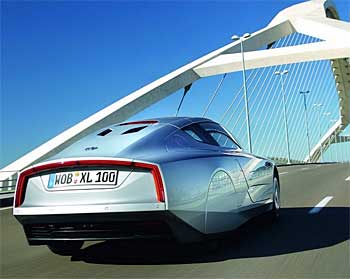VW XL1 Diesel Plug-in Hybrid
At this year's Geneva Motor show, the vehicle being hailed
as the most efficient car in the world has finally been unveiled.
The Volkswagen XL1 Diesel Plug-In hybrid is the culmination
of the company's efforts to create its own ultra-eco-car.
Based on their concept car which was displayed in 2011, this
production ready version is a two seater, turbo diesel, plug
in hybrid, which has been calculated to achieve an incredible
261 miles per gallon. The futuristic styling, which is reassuringly
Volkswagen at the front and amazingly George Jetson at the rear,
is designed to achieve excellent aerodynamics, which produces
almost half the drag coefficient of an average modern car at
just 0.189.
This amazing fuel efficiency is accomplished with only a 0.8
liter diesel engine with a 2 cylinder capacity capable of producing
47 horsepower, with an additional 27 horsepower being delivered
by the electric motor. This can deliver a respectable standard
of performance when combined with the low overall weight of
the car, with the car weighing in at just 1752 pounds, thanks
to its aluminum, carbon fiber and titanium construction materials.
The car features a seven speed gearbox with dual clutch to
enable it to reach a top speed of 98 miles per hour and hit
62 miles per hour in a sluggish 12.7 seconds. However Volkswagen
argues that the performance will not be its major selling point
as even when operating on battery power alone it has a range
of 31 miles and can regenerate its power or be charged via a
plug.
Without the use of the battery, the diesel engine manages 120
miles per gallon but it only requires 6.2 horsepower to maintain
a steady cruising speed of 62 mph. Both rates of miles per gallon
have been based on a European test, so they may have to be adjusted
by the EPA, if the XL1 was to ever make it on sale in the US.
The style features of the XL1 have not been compromised by
the ultra eco production mantra but incorporated, as the rear
wheels have been inset and the lack of door mirrors compensated
by a rear view video camera system. The XL1 also has its share
of equipment advancements with carbon-ceramic brakes, led lamps,
electric air conditioning and heater system compliment the futuristic
styling.
Volkswagen are initially looking at building fifty XL1 vehicles,
in order to gauge the level of demand, with the possibility
of building more if sales are really taking off. It is unlikely
to be built in the mass produced levels of their Golf or Polo
ranges as it will have a much more expensive build cost, with
costs of carbon fiber, a sophisticated battery pack and two
powertrains to add to the almost handcrafted production price
tag.
It is unclear what the actual retail cost of the XL1 would
run to, but speculation has already begun with What Car estimating
$100,000 or more. This being the case it seems that unfortunately
it is very unlikely that it will ever reach the US shores.
Sources:
http://www.npr.org/blogs/thetwo-way/2013/03/05/173521794/vw-introduces-worlds-most-efficient-car-at-geneva-motor-show
http://www.csmonitor.com/Business/In-Gear/2013/0306/Geneva-Motor-Show-Volkswagen-unveils-diesel-plug-in-hybrid
http://news.discovery.com/autos/fuel-and-alternative-fuel-technologies/vw-diesel-plug-in-261-mpg-130305.htm
|

